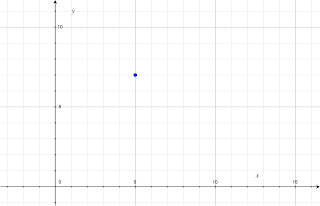 To begin, let's start with a point (5, 7). Now, I ask to find points that are exactly 5 units away from this point.
To begin, let's start with a point (5, 7). Now, I ask to find points that are exactly 5 units away from this point.To begin, it is very straightforward to deduce points that are horizontally and vertically in line with the center point. We simply move 5 units up and down, and left and right. This allows us to identify the points (10, 7), (0, 7), (5, 12), and (5, 2).
After these points, it seems that finding new points gets a bit more difficult. However, it should be fairly obvious that by asking for points that are 5 units away from the center, this is essentially asking for points along a circle with radius of 5. So then, how to find another set of coordinates (x, y)?
If you pay attention to how I have purposefully drawn the radius in the above picture, you will notice that I have inscribed a right angle triangle with a hypotenuse (radius) of 5. This is one of the special triangles, a 3-4-5 triangle. So then, if we then use the dimensions of this triangle, and rotate and flip it around the circle, we can come up with several more exact points that are on the circle: (8, 11), (9, 10), (8, 3), (9, 4), (2, 11), (1, 10), (2, 3), (1, 4).
As you can see, the points that we have identified are beginning to fill out the circle. But, how can we identify even more (x, y) points? It doesn't look like there are any points that lie on whole number integer coordinates left. All that remains are fractional coordinates, and that seems like a lot more work than it's worth to identify more points! Maybe we can find an expression to more accurately pinpoint ordered pairs, that will include all of those that we've already identified plus all of the ones that we can't? Let's go back to our picture, and note the generic triangle now inscribed.
If we say that our radius of 5 is the hypotenuse of a right angle triangle, and we already know what the center point of our circle is, then we can do a bit of arithmetic to come up with generic side lengths for our triangle. If we sweep the radius around the circle, and we always let the inscribed point be called (x, y), then we can state expressions that denote the length of the sides. In this example, the horizontal side is equal to x-5. I've visualized this in the following image.
Similarly, the vertical side length of our new triangle can be shown to be y-7.
Now, since we have described a right angle triangle with defined sides, we can apply the famous Theorem of Pythagoras to this triangle (a2 + b2 = c2). This means that we can come up with the following equation:
And by now, you should recognize that this is the form of the equation of a circle:
Quite simply, this equation looks the way it does because it is based on the Pythagoras Theorem. The circle equation really isn't a difficult one to have to memorize, but hopefully this demonstration has shown you the value of triangles and geometry in deriving more advanced math concepts. Please don't forget to hit the +1 button below, and also follow me on twitter! You can even click here to tweet about my post.
Credit to a YouTube video by DrJamesTanton where I got the idea for this post.







